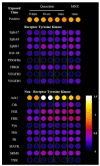Quercitrin Stimulates Hair Growth with Enhanced Expression of Growth Factors via Activation of MAPK/CREB Signaling Pathway
- PMID: 32887384
- PMCID: PMC7504764
- DOI: 10.3390/molecules25174004
Quercitrin Stimulates Hair Growth with Enhanced Expression of Growth Factors via Activation of MAPK/CREB Signaling Pathway
Abstract
The present study aimed to investigate the molecular mechanism of quercitrin, a major constituent of Hottuynia cordata extract, for its hair growth stimulating activities in cultured human dermal papilla cells (hDPCs). Quercitrin enhanced the cell viability and cellular energy metabolism in cultured hDPCs by stimulating the production of NAD(P)H and mitochondrial membrane potential (ΔΨ). The expression of Bcl2, an essential marker for anagen hair follicle and cell survival, was increased by quercitrin treatment. Quercitrin also increased the cell proliferation marker Ki67. The expression of growth factors-such as bFGF, KGF, PDGF-AA, and VEGF-were increased by quercitrin both in mRNA and protein levels. In addition, quercitrin was found to increase the phosphorylation of Akt, Erk, and CREB in cultured hDPCs, while inhibitors of MAPKs reversed the effects of quercitrin. Finally, quercitrin stimulated hair shaft growth in cultured human hair follicles. Our data obtained from present study are in line with those previously reported and demonstrate that quercitrin is (one of) the active compound(s) of Hottuynia cordata extract which showed hair growth promoting effects. It is strongly suggested that the hair growth stimulating activity of quercitrin was exerted by enhancing the cellular energy metabolism, increasing the production of growth factors via activation of MAPK/CREB signaling pathway.
Keywords: CREB; MAPK; growth factors; hair growth; human DPCs; quercitrin.
Conflict of interest statement
The authors declare no conflict of interest.
Figures










Similar articles
-
Hair Growth Promoting Effect of Hottuynia cordata Extract in Cultured Human Hair Follicle Dermal Papilla Cells.Biol Pharm Bull. 2019;42(10):1665-1673. doi: 10.1248/bpb.b19-00254. Biol Pharm Bull. 2019. PMID: 31582654
-
Adenosine stimulates growth of dermal papilla and lengthens the anagen phase by increasing the cysteine level via fibroblast growth factors 2 and 7 in an organ culture of mouse vibrissae hair follicles.Int J Mol Med. 2012 Feb;29(2):195-201. doi: 10.3892/ijmm.2011.817. Epub 2011 Oct 20. Int J Mol Med. 2012. PMID: 22020741
-
Novel effect of sildenafil on hair growth.Biochem Biophys Res Commun. 2018 Nov 2;505(3):685-691. doi: 10.1016/j.bbrc.2018.09.164. Epub 2018 Oct 3. Biochem Biophys Res Commun. 2018. PMID: 30292404
-
Erythropoietin promotes hair shaft growth in cultured human hair follicles and modulates hair growth in mice.J Dermatol Sci. 2010 Aug;59(2):86-90. doi: 10.1016/j.jdermsci.2010.04.015. Epub 2010 May 19. J Dermatol Sci. 2010. PMID: 20554434
-
Chemistry, pharmacokinetics, pharmacological activities, and toxicity of Quercitrin.Phytother Res. 2022 Apr;36(4):1545-1575. doi: 10.1002/ptr.7397. Epub 2022 Mar 7. Phytother Res. 2022. PMID: 35253930 Review.
Cited by
-
Platycladus orientalis Leaf Extract Promotes Hair Growth via Non-Receptor Tyrosine Kinase ACK1 Activation.Curr Issues Mol Biol. 2024 Oct 5;46(10):11207-11219. doi: 10.3390/cimb46100665. Curr Issues Mol Biol. 2024. PMID: 39451545 Free PMC article.
-
Network Pharmacology Reveals Curcuma aeruginosa Roxb. Regulates MAPK and HIF-1 Pathways to Treat Androgenetic Alopecia.Biology (Basel). 2024 Jul 4;13(7):497. doi: 10.3390/biology13070497. Biology (Basel). 2024. PMID: 39056691 Free PMC article.
-
Caizhixuan hair tonic regulates both apoptosis and the PI3K/Akt pathway to treat androgenetic alopecia.PLoS One. 2023 Feb 24;18(2):e0282427. doi: 10.1371/journal.pone.0282427. eCollection 2023. PLoS One. 2023. PMID: 36827412 Free PMC article.
-
Integrative and Mechanistic Approach to the Hair Growth Cycle and Hair Loss.J Clin Med. 2023 Jan 23;12(3):893. doi: 10.3390/jcm12030893. J Clin Med. 2023. PMID: 36769541 Free PMC article. Review.
-
Network Pharmacology Study and Experimental Confirmation Revealing the Ameliorative Effects of Decursin on Chemotherapy-Induced Alopecia.Pharmaceuticals (Basel). 2021 Nov 11;14(11):1150. doi: 10.3390/ph14111150. Pharmaceuticals (Basel). 2021. PMID: 34832932 Free PMC article.
References
-
- Monk B. Hair and its Disorders: Biology, Pathology and Management. J. R. Soc. Med. 2001;94:549. doi: 10.1177/014107680109401023. - DOI
-
- Han S.-H., Byun J.-W., Lee W.-S., Kang H., Kye Y.-C., Kim K.-H., Kim D.-W., Kim M.-B., Kim S.-J., Kim H.-O. Quality of life assessment in male patients with androgenetic alopecia: Result of a prospective, multicenter study. Ann. Dermatol. 2012;24:311–318. doi: 10.5021/ad.2012.24.3.311. - DOI - PMC - PubMed
MeSH terms
Substances
LinkOut - more resources
Full Text Sources
Miscellaneous

